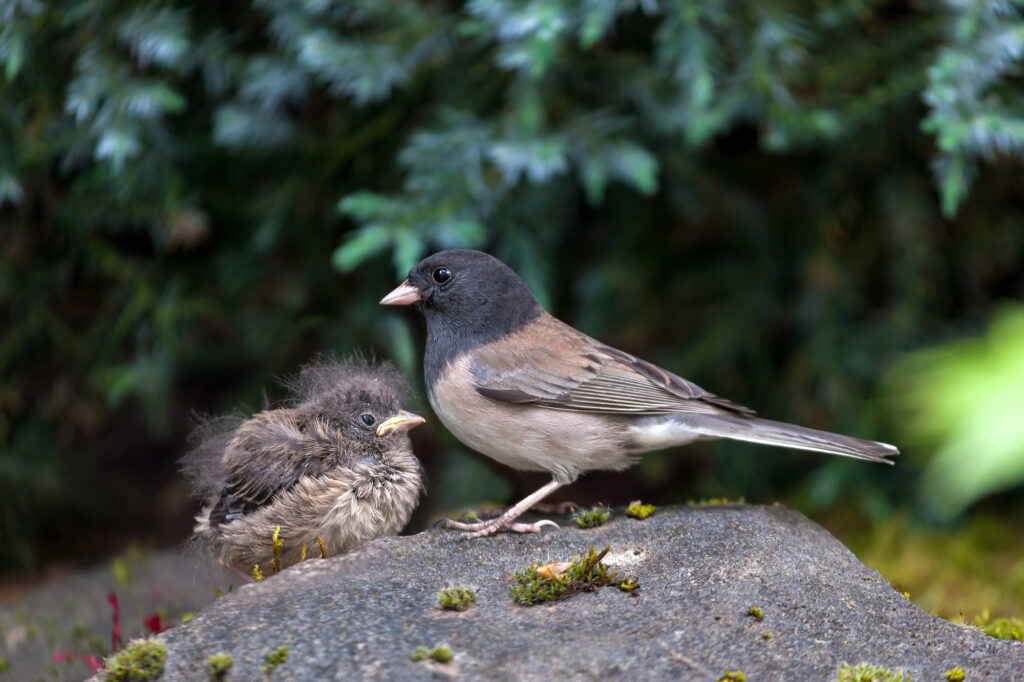Nevada is mostly known as a state full of deserts and canyons, but that doesn’t mean it isn’t a place with thriving wildlife and birdlife!
Hundreds of kinds of birds spend time in Nevada every year, including corvids, redbirds, waterfowl, hummingbirds, and birds of prey.
Of the many birds that live in or visit Nevada, there are 20 kinds of sparrows here. Some of these sparrows stay year-round in Nevada, while others are here for just the summer or winter. A handful of them also stop briefly in Nevada as they migrate between winter and summer territories.
Let’s take a look at these 20 kinds of sparrows and find out what makes each one unique.
What Is a Sparrow?
You may have heard of a bird referred to as a “little brown job,” or even an “LBJ” for short. This is a label applied to sparrows – all kinds of sparrows – thanks to their mostly plain brown appearance.
Sparrows may not be very flashy, but they are still fascinating. They are excellent at camouflage, and some will spend almost all of their time under the protection of shrubs, undergrowth, and thickets.
Sparrows are similarly sized: about 5-7 inches long. They tend to be mostly brown and streaky in appearance, sometimes with a flash of color like yellow, orange, or rufous.
They have strong, sharp bills that are conical in shape. Perfect for breaking into nuts and seeds!
Their tail shape, wing shape, and overall patterns vary from species to species. Sparrows that live in muddy conditions usually have longer, stronger legs, whereas others have delicate little legs.
It’s a really fun challenge for birders to work on being able to identify different kinds of sparrows!
How Many Sparrows Are in Nevada?
Although our list only includes 20 kinds of sparrows, there are occasionally other species that make their way through Nevada. These are called migratory vagrants because they are off their normal course.
We aren’t going into detail about these sparrows, as we want to help you identify the sparrows that you are likely to see in Nevada, not the super rare ones that you’ll probably never encounter.
To make our list as useable as possible, we have divided the sparrows into four categories: sparrows that are in Nevada year-round, those in Nevada for the summer, those that arrive and stay for the winter, and those that only stop by during migration.
How To Identify a Sparrow
Even though it’s a challenge to identify sparrows, it’s not impossible. Plenty of birders learn to quickly and effectively distinguish between the many different kinds of sparrows they might encounter out in the world.
We recommend paying attention to the following traits so that you can identify sparrows correctly:
- What color is the bird? (Note its face, chest, nape, belly, flanks, tail, and wings)
- What patterns do you see in its coloring? (Stripes, streaks, patches, etc)
- What is their shape (AKA: silhouette)?
- Where did you see the sparrow? (Both where in the state and in what specific habitat)
- What were they doing when you saw them? (Hiding, perching, diving, attacking, eating, etc)
- If they were eating, what were they eating?
- When did you see them? (Time of day, time of year)
With all of this information, you can get started on identifying sparrows in Nevada. So let’s get to the list!
Sparrows in Nevada All Year
You can find seven kinds of sparrows in Nevada all year long: the Albert’s Towhee, the Bell’s Sparrow, the Dark-Eyed Junco, the House Sparrow, the Rufous-Crowned Sparrow, the Sagebrush Sparrow, the Song Sparrow, the Spotted Towhee, and the White-Crowned Sparrow.
Abert’s Towhee

- Melozone aberti
- ORDER: Passeriformes
- FAMILY: Passerellidae
- Length: 8.3-9.1 in (21.2-23.1 cm)
- Weight: 1.5-1.9 oz (42.5-54.9 g)
- Wingspan: 10.4-11.6 in (26.5-29.5 cm)
Albert’s Towhee is larger than most other sparrows. It’s about the size of a robin. Its roundish body is similar to that of a Northern Cardinal, but the Albert’s Towhee does not have a crest, and its pale gray bill is shorter. There is some black around its bill, too.
This bird is grayish-brown on its back and wings and head. Its belly and chest are very pale pinkish-brown. Under its tail feathers, you’ll find some rusty coloring.
Albert’s Towhees live in the very thick brush of the arid Sonoran Desert. They are non-migratory birds who stay put all year. You will only find them in Nevada along the state’s southeastern border.
Bell’s Sparrow

- Artemisiospiza belli
- ORDER: Passeriformes
- FAMILY: Passerellidae
- Length: 7.5-9.8 in (19-25 cm)
- Weight: 0.85-1.39 oz (24-39.5 g)
- Wingspan: 8.25 in (21 cm)
From above, the Bell’s Sparrow is dark brown and has a gray head. Its belly is white and streaky, and it has a dark patch centered on its chest. Its facial markings include white eyerings, stark white and gray stripes on the throat, and a white spot before each eye.
Bell’s Sparrows are ground-dwellers but, like others on this list, males will perch in the spring and early summer to sing.
They are year-round residents of southwestern Nevada, near the Mojave Desert. They thrive in scrubby areas that are full of plants like sagebrush and recently burned-out chaparral.
Dark-Eyed Junco
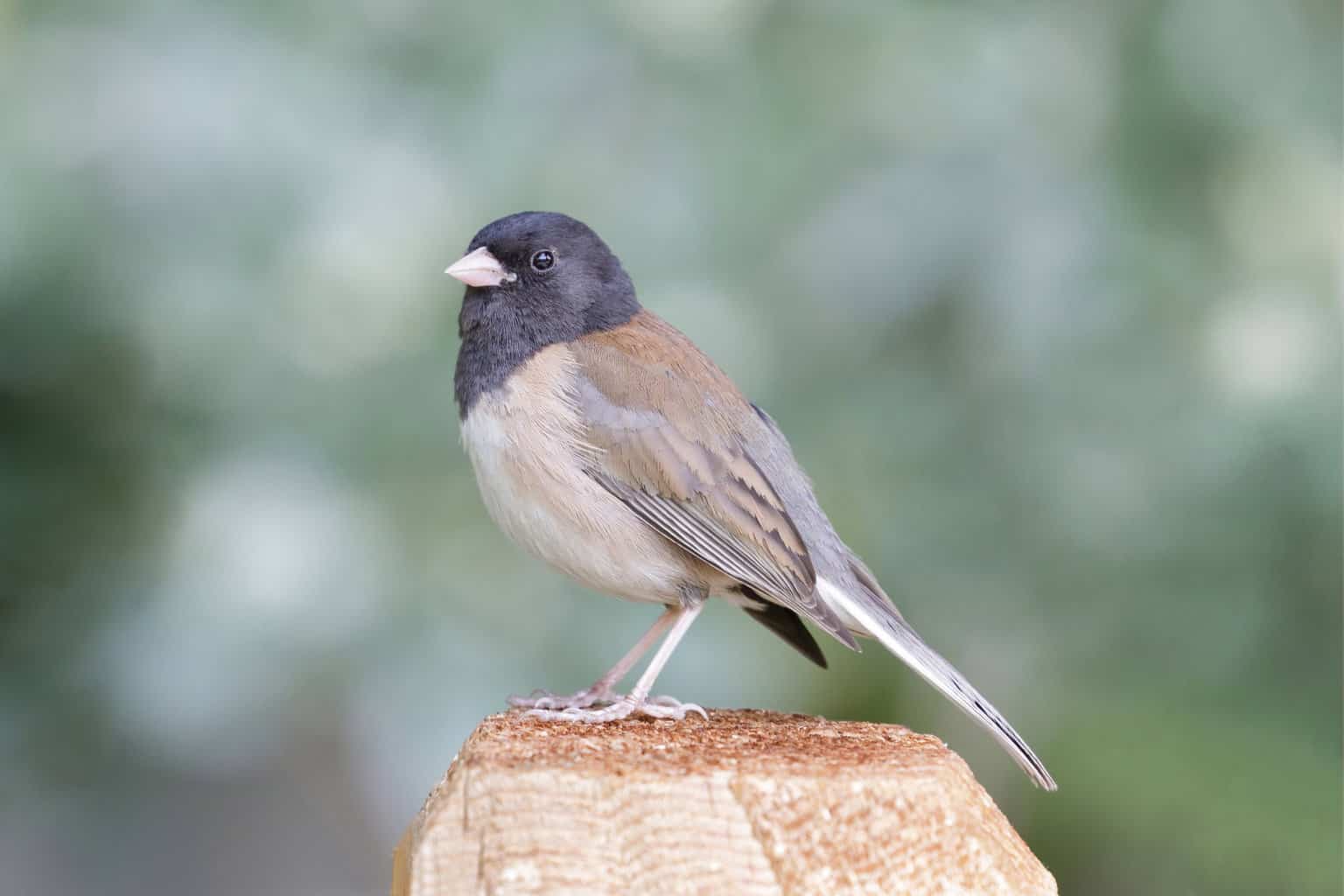
- Junco hyemalis
- ORDER: Passeriformes
- FAMILY: Passerellidae
- Length: 5.5-6.3 in (14-16 cm)
- Weight: 0.6-1.1 oz (18-30 g)
- Wingspan: 7.1-9.8 in (18-25 cm)
Dark-Eyed Juncos are associated with winter in most of the US, but they are found year-round in all of Nevada. They are sometimes called “snowbirds.”
The Dark-Eyed Junco has a dark gray head, back, and wings, and a light gray belly and underside. Their bill is pink.
You can find Dark-Eyed Juncos in a variety of habitats in the winter, including parks, fields, woods, and backyards. They live at elevations from sea level to above 11,000 feet. They are frequent visitors to backyard bird feeders, too.
During the summer, they are more likely found in coniferous forests. Although coniferous forests aren’t common in Nevada, there are some in the state’s mountains.
House Sparrow

- Passer domesticus
- ORDER: Passeriformes
- FAMILY: Passeridae
- Length: 5.9-6.7 in (15-17 cm)
- Weight: 0.9-1.1 oz (27-30 g)
- Wingspan: 7.5-9.8 in (19-25 cm)
House Sparrows are found nationwide, including all of Nevada. They are an invasive species that displaces native species from their nesting grounds by successful breeding and over-competition for food. They are even known to attack and kill other birds in order to take their territory.
Male House Sparrows are rufous-necked with a black bib, white cheeks, and a gray head. Females, on the other hand, are mostly brown and have black stripes up and down their backs and wings.
House Sparrows don’t live in fields, forests, mountains, or deserts. They live only where there are people. How, then, are they widespread across Nevada, which has miles upon miles of uninhabited land? The answer is that they will find their way to a house, barn, or business in a secluded area and make their home there – even if there is mostly wilderness surrounding them.
They prefer rafters, roofs, outbuildings, and even skyscrapers in urban areas.
Rufous-Crowned Sparrow
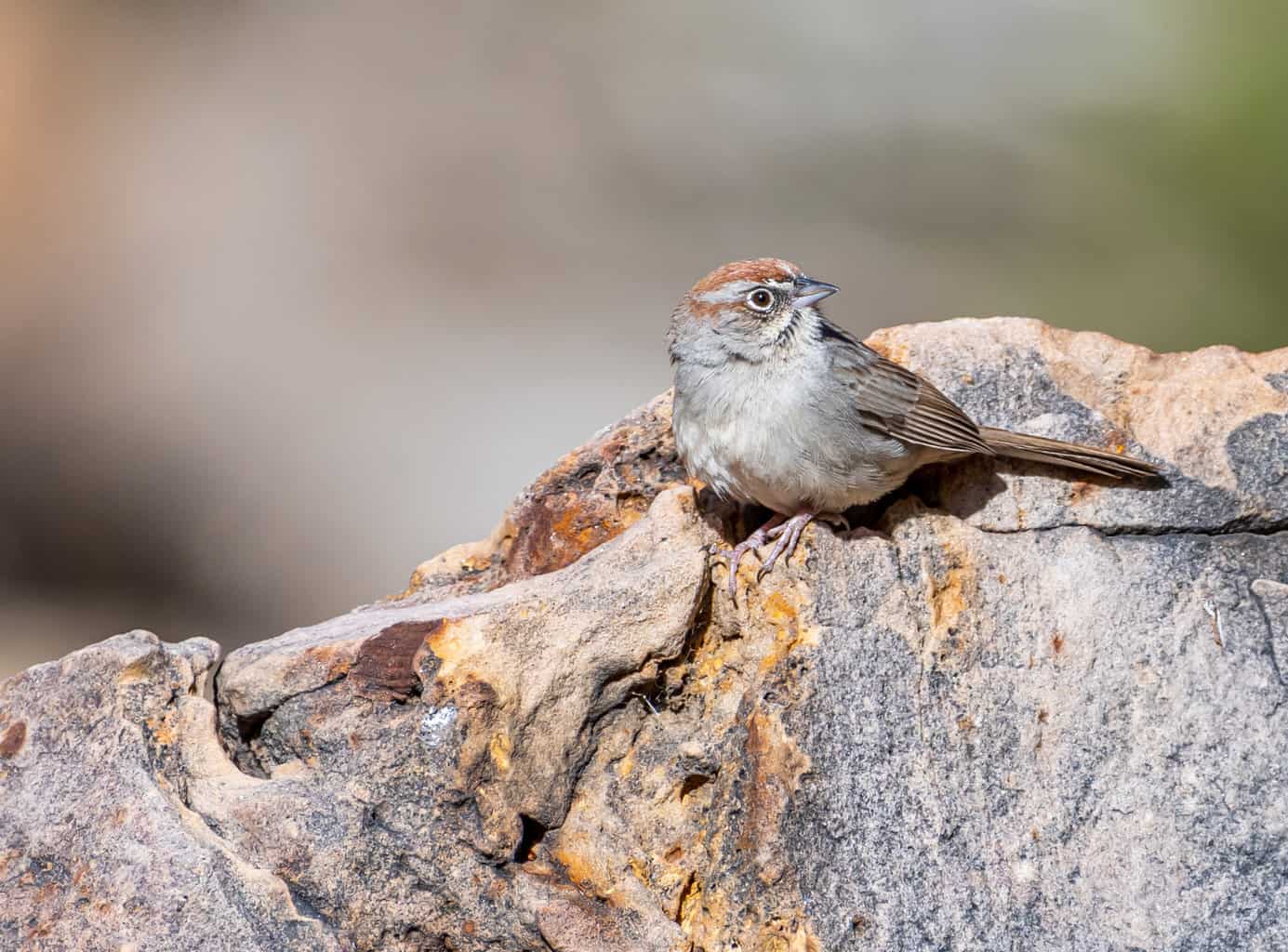
- Aimophila ruficeps
- ORDER: Passeriforme
- FAMILY: Passerellidae
- Length: 5.25 in (13.3 cm)
- Weight: 15- 23 g (0.53 – 0.81 oz)
- Wingspan: 7.75 in (19.68 cm)
Rufous-Crowned Sparrows may be somewhat drab, but look for their rufous cap to identify them. Additionally, they have a streaky back, gray body, white eyering, and whisker markings.
Rufous-Crowned Sparrows are generally sedentary. They spend a lot of time hiding under thick vegetation. Even when frightened, they are more likely to scurry away on the ground than they are to burst into flight.
That said, males will perch in a short shrub or low in a tree to sing their song.
Rufous-Crowned Sparrows are more likely to be found in southern California, Arizona, and New Mexico than Nevada, but there is a small area near the small towns of Schellbourne and Cherry Creek that sees them all year round.
They tend to nest in rocky hillsides, right on the ground.
Sagebrush Sparrow
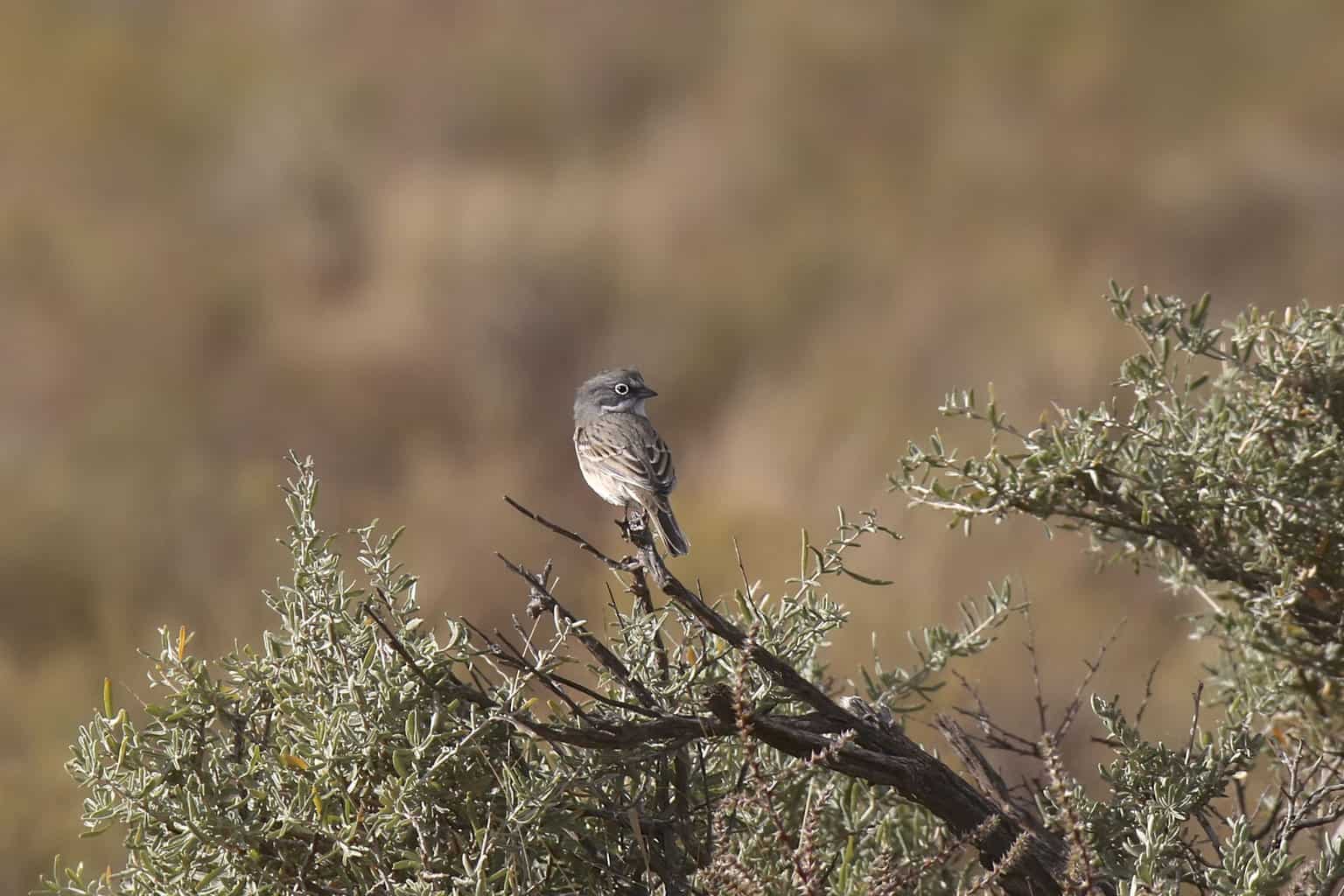
- Artemisiospiza nevadensis
- ORDER: Passeriformes
- FAMILY: Passerellidae
- Length: 4.7-5.9 in (12 – 15 cm)
- Weight: 0.5-.08 oz (15-22 g)
- Wingspan: 8.25 in (20.95 cm)
The Sagebrush Sparrow is a brown, medium-sized sparrow with a long dark tail, round head, and short, thick bill. On its face, the Sagebrush Sparrow has a white spot right before its eyes, a dark stripe around the throat, and a white eyering.
Sagebrush Sparrows get their name from the sagebrush that dominates the landscape where they live. In Nevada, they can be found year-round in the Desert National Wildlife Range area. They are usually hidden in the shrubby bushes, although males will perch and sing during the spring.
They frequently breed with other sparrows, creating hybrid species.
Song Sparrow

- Melospiza melodia
- ORDER: Passeriformes
- FAMILY: Passerellidae
- Length: 4.7-6.7 in (12-17 cm)
- Weight: 0.4-1.9 oz (12-53 g)
- Wingspan: 7.1-9.4 in (18-24 cm)
Song Sparrows vary in appearance from region to region. They are all brown with white streaks on their chests, but the amount of streaking is dependent upon where you find them. Desert Song Sparrows tend to be much lighter than their coastal relatives.
Song Sparrows are year-round residents found throughout Nevada. In the summer, they use the exact same nesting grounds as the previous year. In fact, they will even use the same nest.
They build nests close to one another, sometimes on the ground but sometimes up to 15 feet above the ground in bushes and trees. They tend to nest near water sources. Unlike sparrows that avoid humans, Song Sparrows don’t mind human activity. They will often nest near houses or even in landscaping beds.
Spotted Towhee
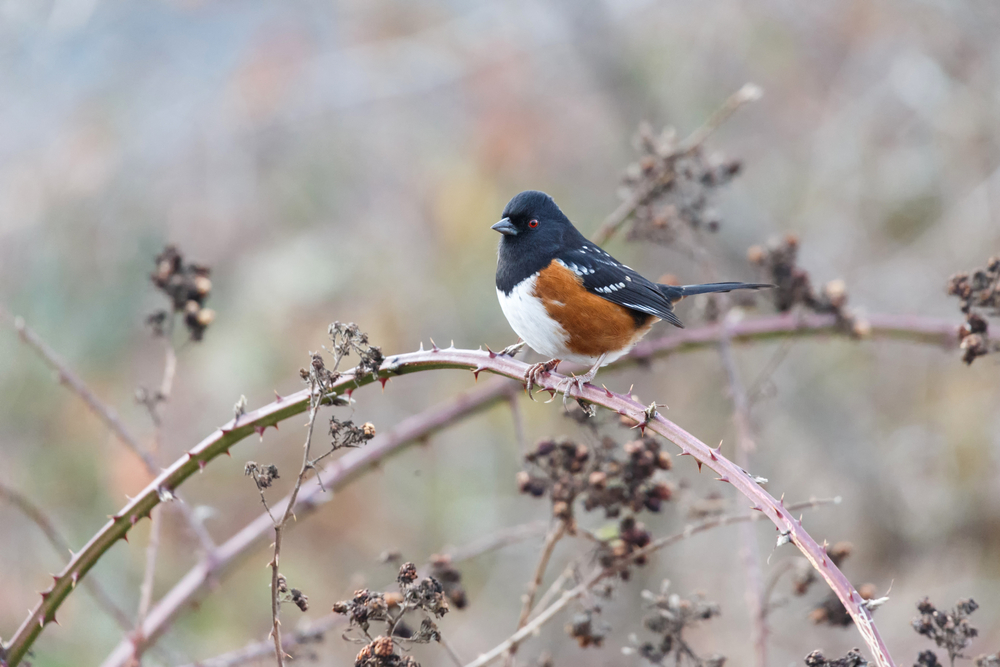
- Pipilo maculatus
- ORDER: Passeriformes
- FAMILY: Passerellidae
- Length: 6.7-8.3 in (17-21 cm)
- Weight: 1.2-1.7 oz (33-49 g)
- Wingspan: 11.0 in (28 cm)
Spotted Towhees are fairly large sparrows. Males are tri-colored. Their throat, head, and wings are black, their belly is white, and their sides are rufous.
They look similar to their close relative the Eastern Towhee, but Eastern Towhees stay in the eastern half of the US. Spotted Towhees have white spots on their black wings.
Females are grayish-brown anywhere that males are black.
Spotted Towhees are year-round residents of almost all of Nevada, although they don’t usually spend time in the Lake Tahoe region. Their summer diet consists of insects, including grasshoppers, caterpillars, ladybugs, beetles, weevils, moths, wasps, and bees. In the winter, they switch to a seed-based diet. They eat raspberries, thistles, sumac, poison oak, blackberries, corn, oats, cherries, chickweed, and other seeds, nuts, and berries.
White-Crowned Sparrow
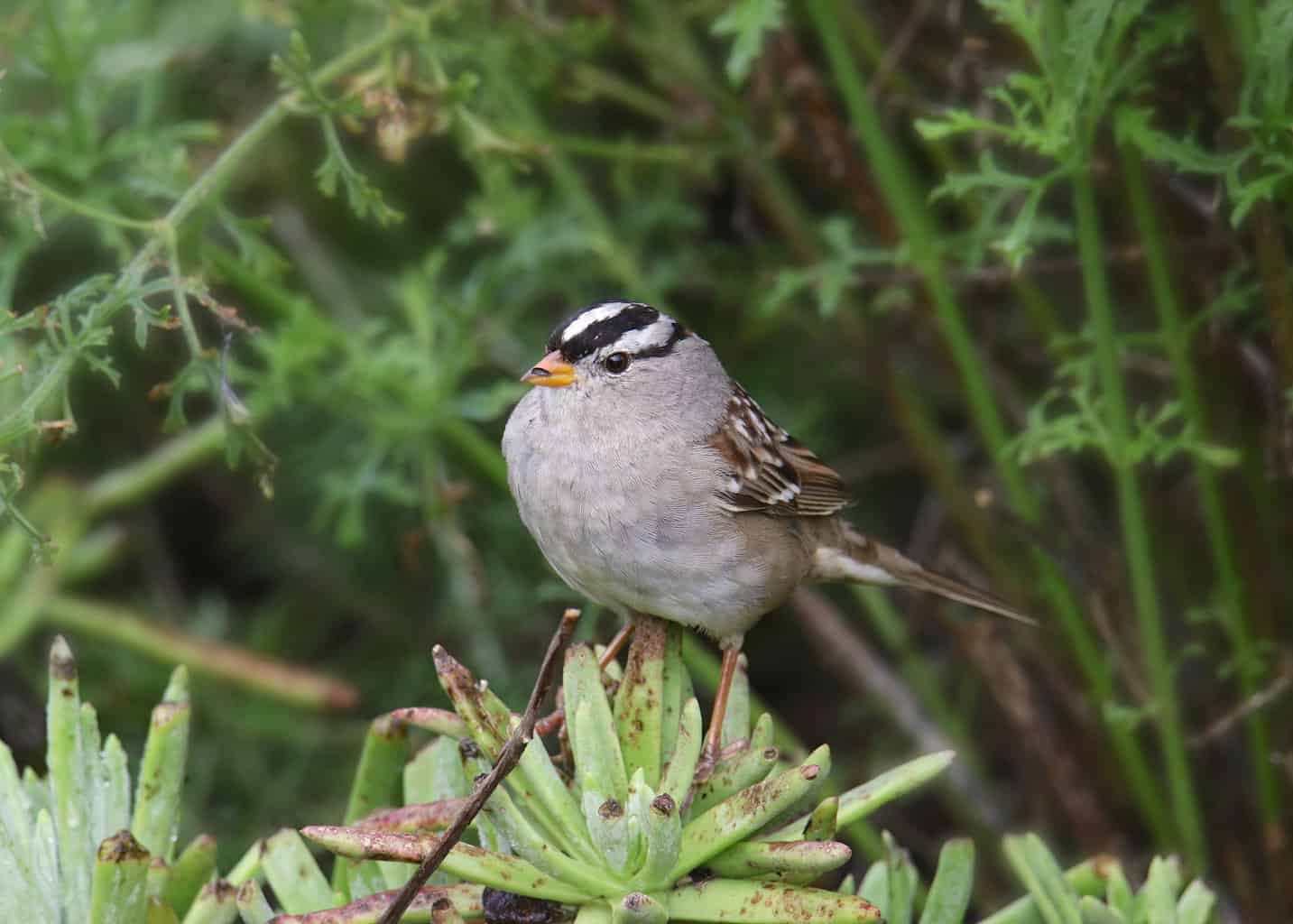
- Zonotrichia leucophrys
- ORDER: Passeriformes
- FAMILY: Passerellidae
- Length: 5.9-6.3 in (15-16 cm)
- Weight: 0.9-1.0 oz (25-28 g)
- Wingspan: 8.3-9.4 in (21-24 cm)
The White-Crowned Sparrow is a grayish-brown bird with stark black and white stripes on its head. Its bill is either pink or yellow. Juveniles have brown stripes instead of black ones.
White-Crowned Sparrows nest in shrubby fields and along forest edges. They need to have both uncovered ground and grassy patches so that they can forage and hide. White-Crowned Sparrows (and Towhees) perform a behavior called “double-scratching” while they forage.
First, they hop backward, which flips over a leaf. Then, after revealing what’s underneath, they quickly hop forward again to snatch their food.
They are year-round residents of Central Nevada and the Tahoe/Reno region, but they are only found in Southern Nevada and along the state’s eastern border during the winter.
Sparrows in Nevada in the Summer
Nevada’s summer-only sparrows are the Black-Chinned Sparrow, the Black-Throated Sparrow, the Brewer’s Sparrow, the Chipping Sparrow, the Fox Sparrow, the Green-Tailed Towhee, the Lark Sparrow, and the Savannah Sparrow.
Remember that you will also see those year-round sparrows in the summer, too.
Black-Chinned Sparrow
- Spizella atrogularis
- ORDER: Passeriformes
- FAMILY: Passerellidae
- Length: 5-5.25 in (13-15 cm)
- Weight: 0.3-0.5 oz (9.0-14.8 g)
- Wingspan: 7.75 in (19-20 cm)
Black-Chinned Sparrows, as you probably could have guessed, have a black chin – but only males, and only in the breeding season. Otherwise, the Black-Chinned Sparrow’s body is dark gray with no obvious streaking except on the wings. Their wing streaks are brown and the bill is pink.
They live in dry, shrubby, hilly habitats in the Southwestern US. During the winter, they migrate to Mexico.
You can find them in the summer in Nevada in the Desert National Wildlife Range and Red Rock Canyon National Park.
They are known for the male’s unusual song, which sounds like a rapidly bouncing ping-pong ball that just gets faster and faster. Males and females alike will also make a high-pitched chipping sound to warn that predators are near the nest.
Black-Throated Sparrow
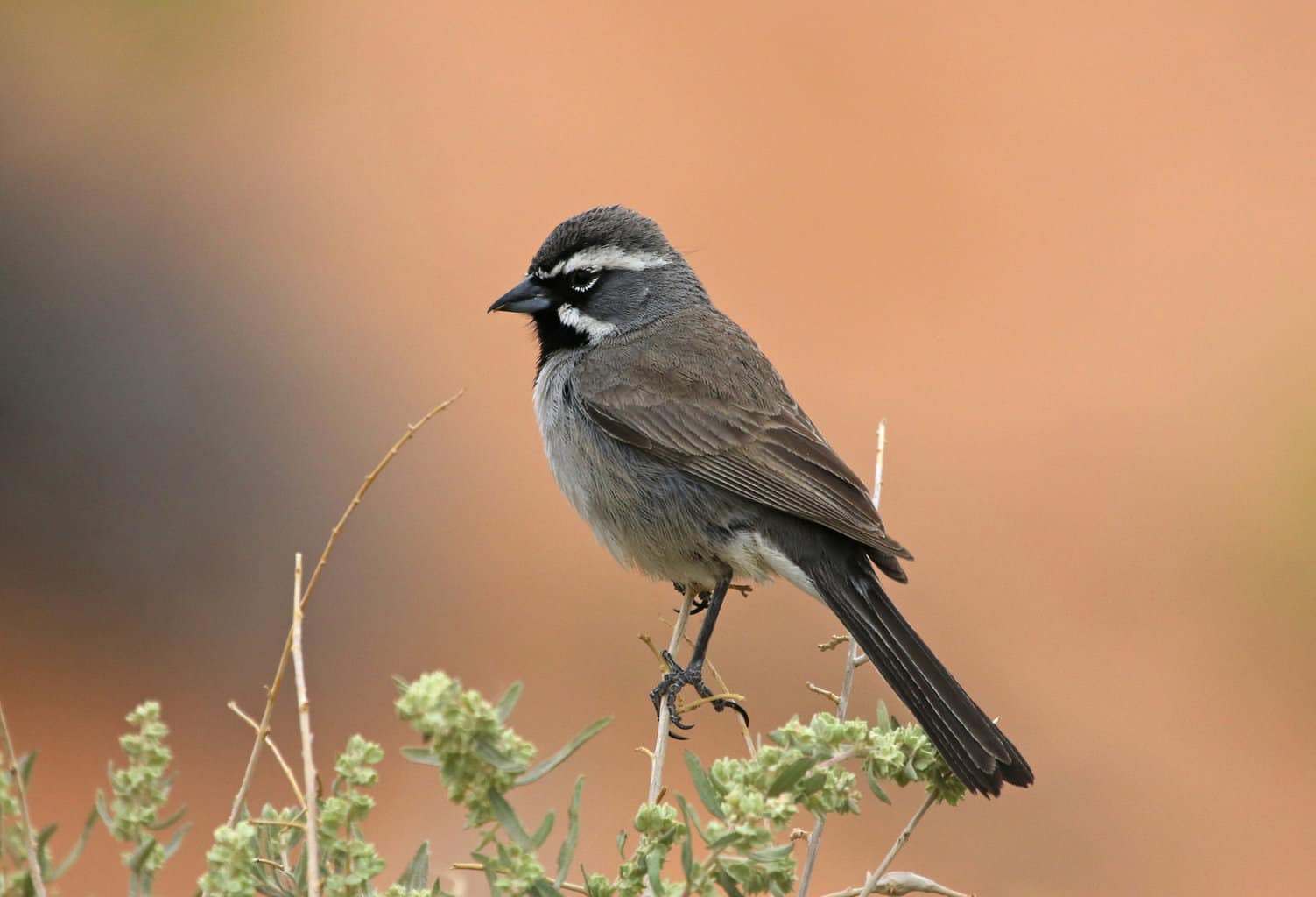
- Amphispiza bilineata
- ORDER: Passeriformes
- FAMILY: Passerellidae
- Length: 4.7-5.5 in (12-14 cm)
- Weight: 0.4-0.5 oz (11-15 g)
- Wingspan: 7.7 in (19.5 cm)
Black-Throated Sparrows have grayish-brown bodies, rounded heads, and dark tails with white edges. Their unique facial pattern makes them relatively easy to recognize: look for a gray face with two bold white stripes and a black “eyebrow” on each side.
They have a black triangular patch on the throat, too.
These are widespread throughout most of Nevada during the summer, but they don’t spend any time in the Lake Tahoe area. They are year-round residents of the far southeastern corner of the state.
They live in shrubby areas with short, scattered trees. This means that canyons and desert washes are their ideal habitat, especially if there are bushes and trees like ocotillo, creosote, acacia, sagebrush, mesquite, cholla, and rabbitbrush. They are also comfortable in high altitudes, sometimes living up to 7,000 feet above sea level.
Brewer’s Sparrow
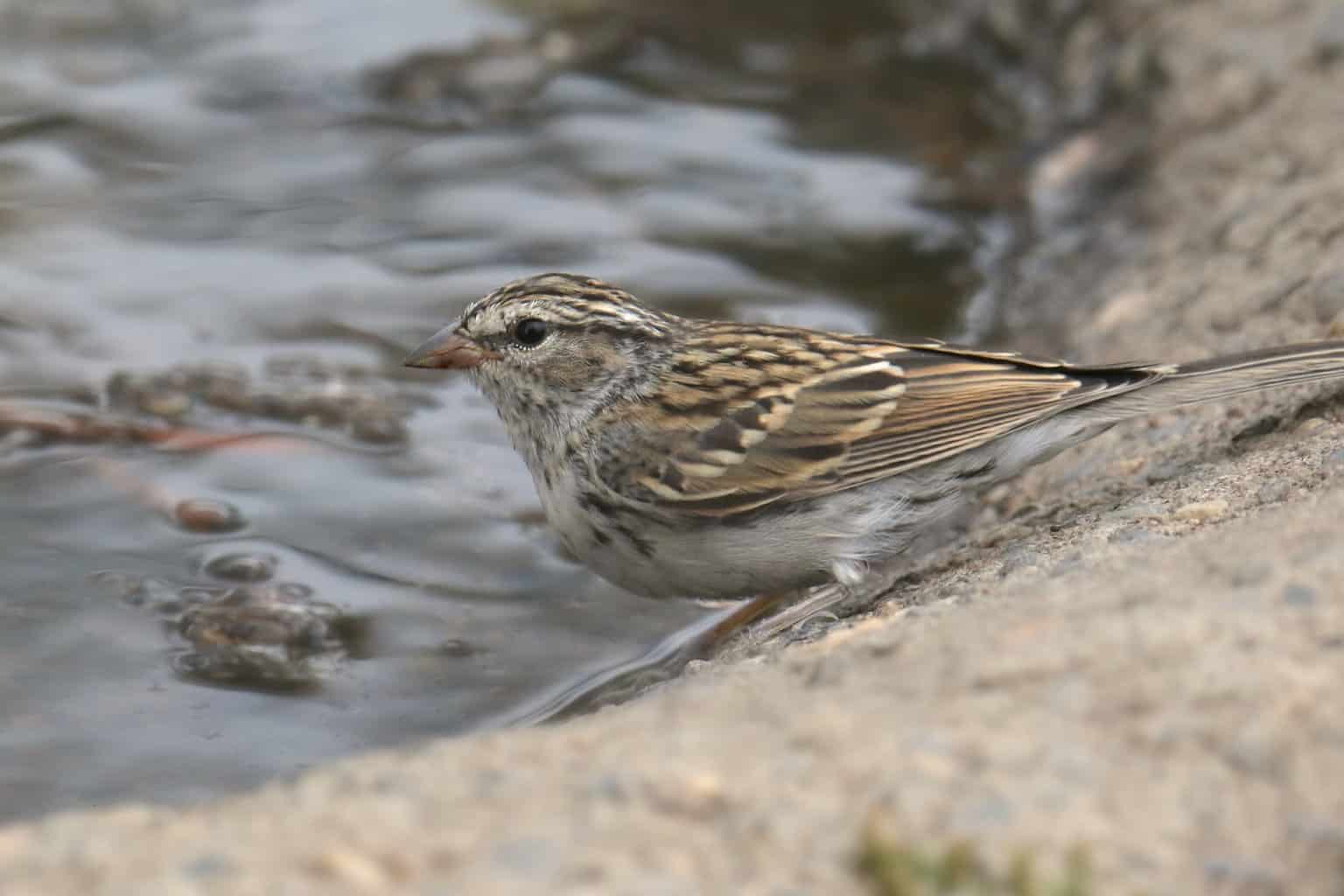
- Spizella breweri
- ORDER: Passeriform
- FAMILY: Passerellidae
- Length: 5.1-5.9 in (13-15 cm)
- Weight: 0.4-0.5 oz (11-14 g)
- Wingspan: 7.1-7.9 in (18-20 cm)
Brewer’s Sparrows are the smallest sparrow in North America. They are mostly grayish-brown, but their back and neck are striped in brown. Their tail is notched, and their wings are rounded. They also have a white eyering and a light gray stripe over their eyes.
They live exclusively in the western half of North America. They migrate to their summer territory (including Nevada) late in the spring, then leave again in early fall.
They are actually the most abundant bird in the US’s Interior West! To find them, listen out for their long, trilling song in the late spring and early summer.
Brewer’s Sparrows are usually hidden among the underbrush.
They are year-round residents of the Tahoe area, and they are only in the Las Vegas area in the winter. In the rest of the state, they are plentiful all summer long.
Chipping Sparrow
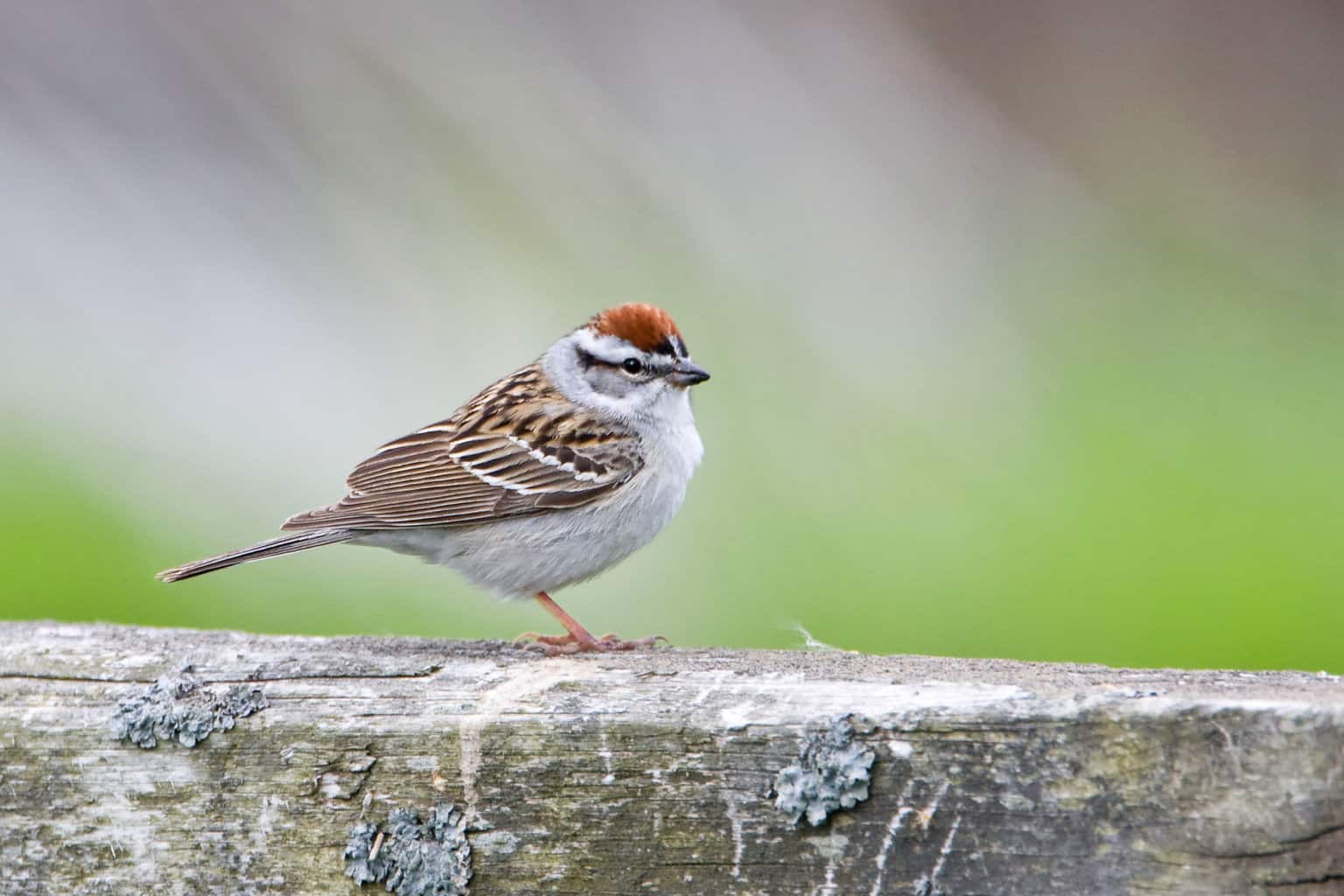
- Spizella passerina
- ORDER: Passeriformes
- FAMILY: Passerellidae
- Length: 4.7-5.9 in (12-15 cm)
- Weight: 0.4-0.6 oz (11-16 g
- Wingspan: 8.3 in (21 cm)
Chipping Sparrows are another widespread North American bird. Their breeding territory includes almost every US state and most of Canada! Their winter territory includes Florida, Mexico, and the Caribbean. In Nevada, they are summer residents across most of the state.
Males have a rufous cap and black eye stripes. The streaks on their wings and back are dark. Females are generally darker than males.
They eat insects and bugs all summer long, helping to maintain a healthy ecosystem. They eat caterpillars, beetles, grasshoppers, leafhoppers, and even spiders.
They build a cup-shaped nest on the ground from weeds, stems, roots, and leaves.
Fox Sparrow

- Passerella iliaca
- ORDER: Passeriformes
- FAMILY: Passerellidae
- Length: 5.9-7.5 in (15-19 cm)
- Weight: 0.9-1.6 oz (26-44 g)
- Wingspan: 10.5-11.4 in (26.7-29 cm)
Fox Sparrows are reddish brown and gray, with quite a bit of regional variation. They can be mostly red or mostly gray with just a bit of red streaking. They have identifiable brown chest spots, too.
These larger-sized sparrows kick lots of leaf litter around as they forage for food on the ground. They will happily visit backyard bird feeders in Nevada’s cities and towns. Because they have hitched a ride on international ships, Fox Sparrows have also been found in far-flung places like Germany, Iceland, Italy, and Greenland.
Most of Nevada will only see Fox Sparrows during their migration windows, but they live in the summer along the northern border, near Lake Tahoe, and in small communities across the middle of the state.
Green-Tailed Towhee
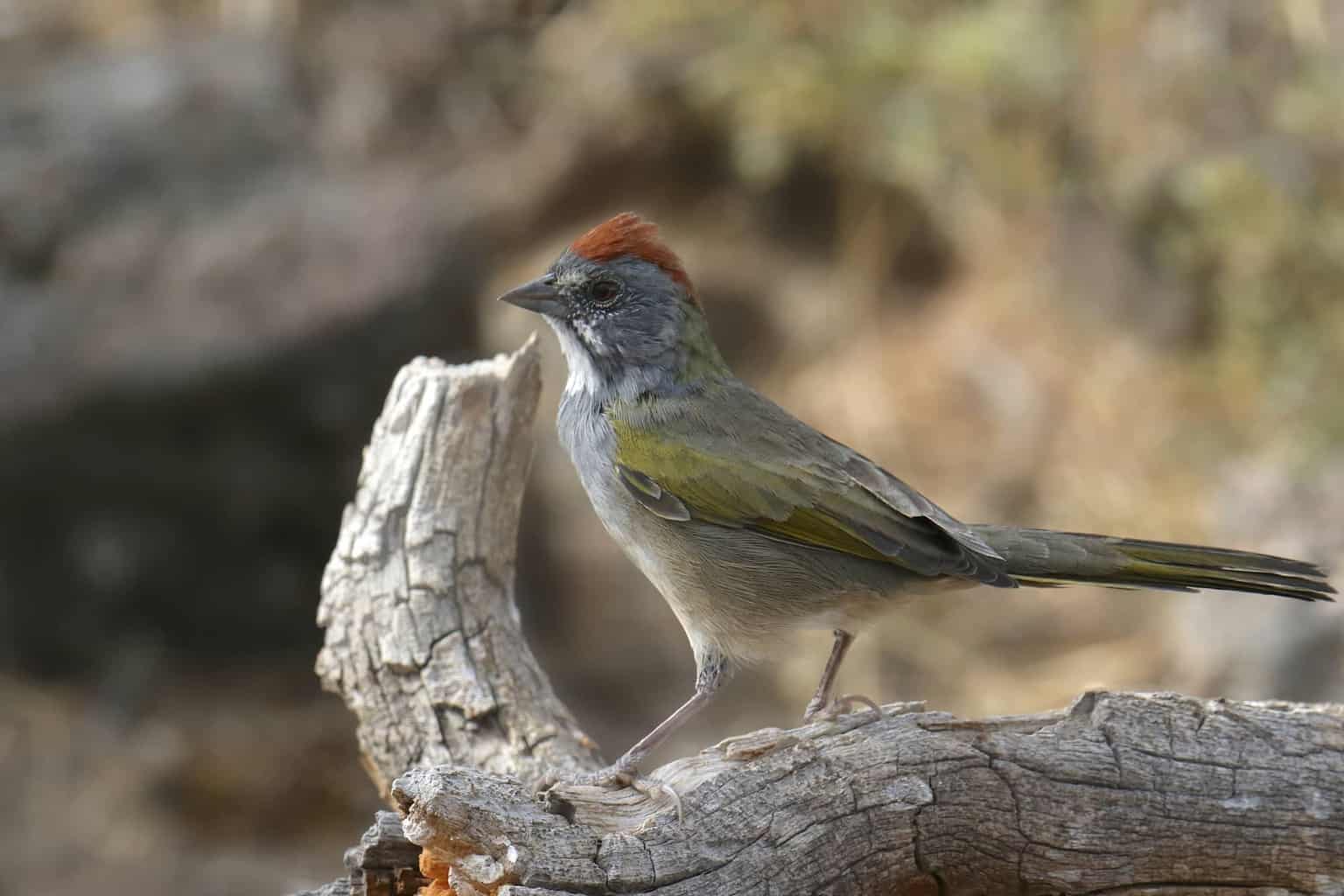
- Pipilo chlorurus
- ORDER: Passeriformes
- FAMILY: Passerellidae
- Length: 8.3-9.8 inches (21–25 cm)
- Weight: 1.3-2.4 oz (37-67 g)
- Wingspan: 11.4 inches (29 cm)
The Green-Tailed Towhee is likely the prettiest sparrow in Nevada.
Their bodies are gray with a wash of beautiful green on their wings and tails. Their rufous crown is a beautiful contrast to the rest of their body. They also have a white throat and a dark stripe of a “mustache” on their face.
These lovely birds live in most of Arizona during the summer. They are year-round residents of the southern part of the state – specifically in Clark County.
Lark Sparrow
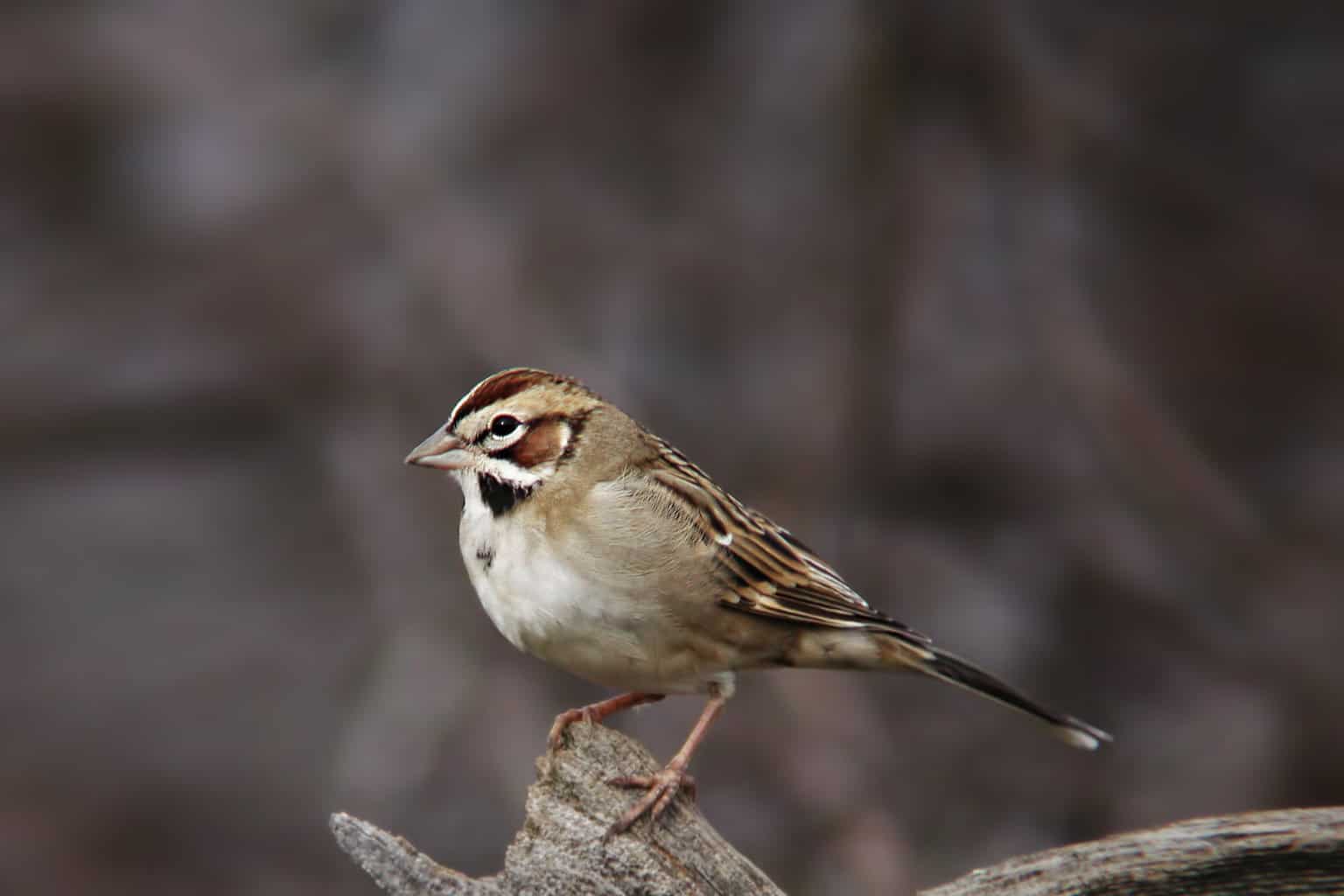
- Chondestes grammacus
- ORDER: Passeriformes
- FAMILY: Passerellidae
- Length: 5.9-6.7 in (15-17 cm)
- Weight: 0.8-1.2 oz (24-33 g)
- Wingspan: 11.0 in (28 cm)
The bulky Lark Sparrow has a gray body, a long, rounded tail, and a face lined with brown stripes. The easiest way to differentiate a Lark Sparrow from other similarly-patterned sparrows is to look for the black chest patch.
Lark Sparrows have been experiencing a decline in population, but they are still considered a species of low concern when it comes to conservation. There are an estimated 11 million Lark Sparrows, most of which are in North America.
They used to be found as far as the East Coast, but now their breeding territory starts in Ohio and moves westward.
They are ground foragers who eat lots of insects in the summer when they are in Nevada. They breed throughout most of the state, but they are only seen along the Southern border when they are migrating between breeding and winter territories.
Savannah Sparrow
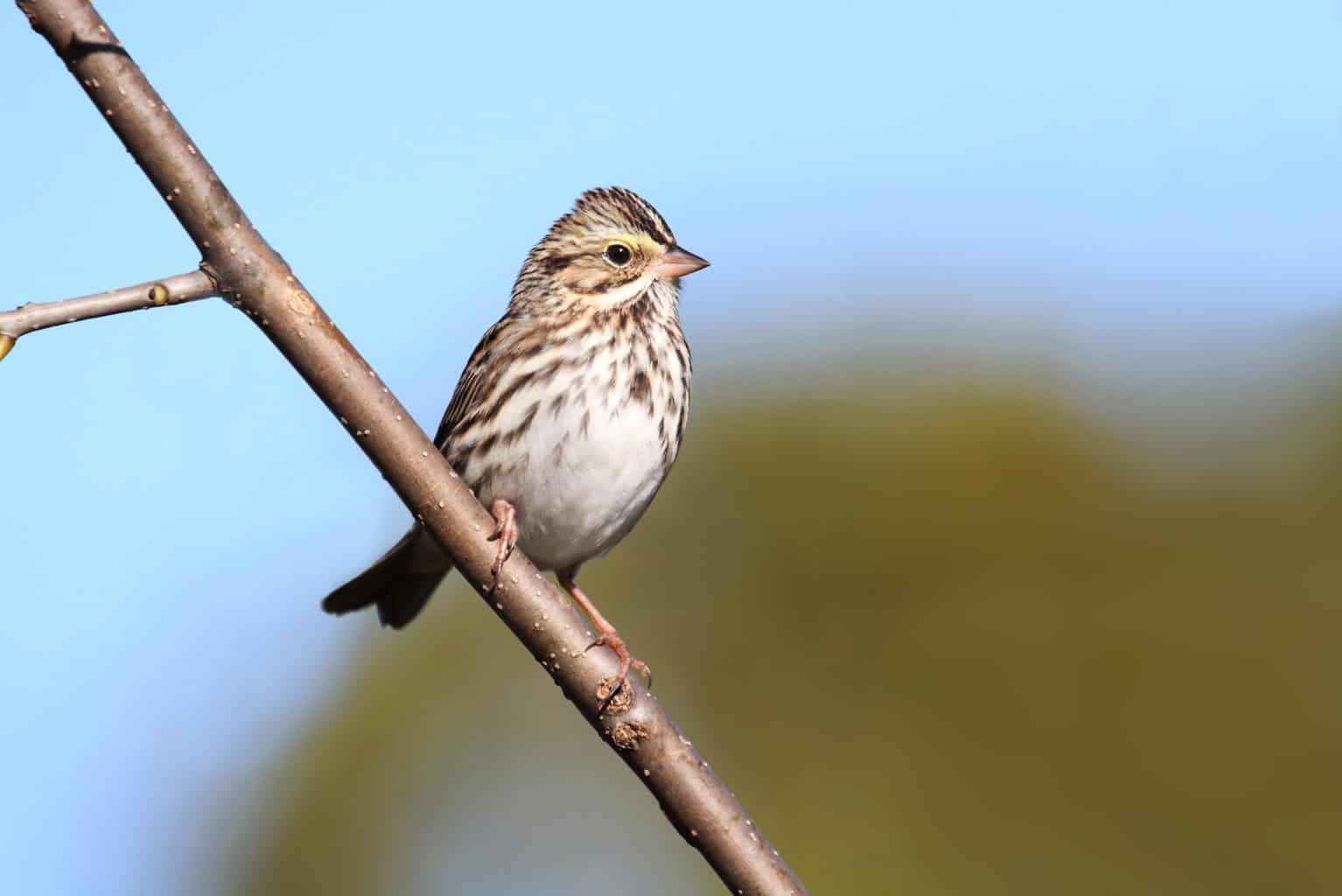
- Passerculus sandwichensis
- ORDER: Passeriformes
- FAMILY: Passerellidae
- Length: 4.3-5.9 in (11-15 cm)
- Weight: 0.5-1.0 oz (15-28 g)
- Wingspan: 7.9-8.7 in (20-22 cm)
The Savannah Sparrow has dark streaks on its back and wings, a sharp bill, and some yellow between its eyes and bill. That yellow patch makes the Savannah Sparrow quite easy to identify!
Savannah Sparrows are widespread during the breeding season, including throughout most of Nevada. They also spend the winter in the area around Las Vegas and the Desert National Wildlife Range.
Savannah Sparrows live mostly in grasslands, both in the summer and the winter. They live in meadows and pastures, in grassy patches along the road, and in cover-crop fields (like Alfalfa, an important agricultural product of Nevada).
Sparrows in Nevada in the Winter
The two kinds of sparrows that live in Nevada in the winter are the American Tree Sparrow and the Golden-Crowned Sparrow.
American Tree Sparrow
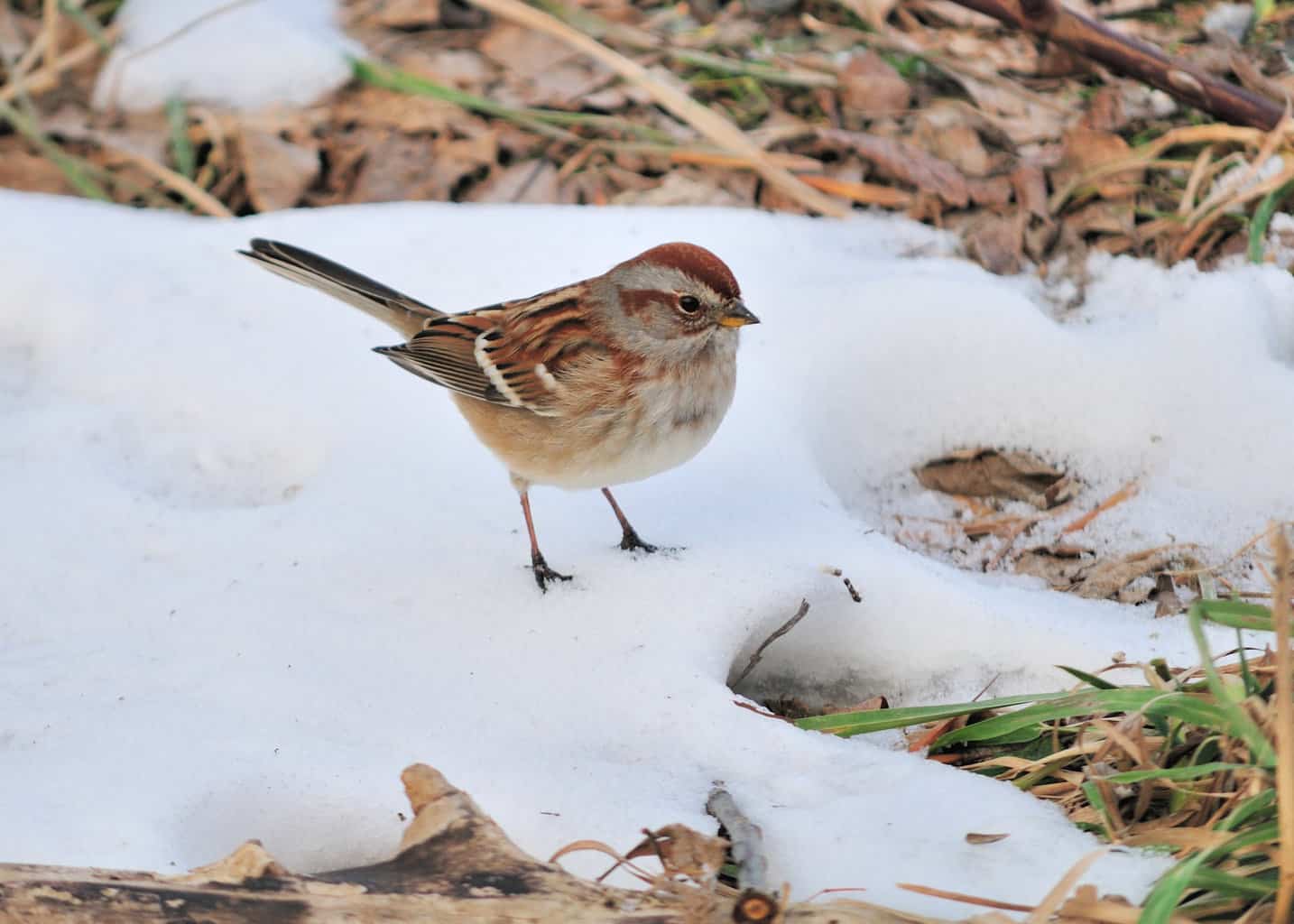
- Spizelloides arborea
- ORDER: Passeriformes
- FAMILY: Passerellidae
- Length: 5.5 in (14 cm)
- Weight: 0.5-1.0 oz (13-28 g)
- Wingspan: 9.4 in (24 cm)
Some American Tree Sparrows are easier to identify than others, thanks to a red breast patch that is inconsistent from bird to bird.
Otherwise, they are gray with striped wings and dark reddish-brown crowns.
They breed throughout northern Canada and winter in most of the US. Nevada marks the southern edge of their winter range. They do not spend the winter along the state’s sloping southern border.
Although they may migrate long distances, American Tree Sparrows look for similar things in both their winter and summer habitats. Specifically, they like open land near the woods, nearby water, and plenty of weeds and hedgerows.
Golden-Crowned Sparrow

- Zonotrichia atricapilla
- ORDER: Passeriformes
- FAMILY: Passerellidae
- Length: 6-7 in (15-18 cm)
- Weight: 0.67-1.25 oz (19-35.4 g)
- Wingspan: 9.74 in (24.75 cm)
The Golden-Crowned Sparrow’s appearance varies quite a bit between the summer and winter. During the breeding season, males and females have a bright yellow forehead, a black crown, and a lot of gray and brown streaking. During the winter, which is when they are in Nevada, they are dully colored with a less vibrant yellow cap.
Golden-Crowned Sparrows prefer weedy and shrubby lowlands, often close to cities. Their breeding habits are a bit of a mystery because they migrate so far into Alaska that humans have little opportunity to observe them.
The story goes that gold miners during the Gold Rush were comforted by the lovely, melancholy song of the Golden-Crowned Sparrow.
They are only found in a few places in Nevada: Western Nevada (mostly near Tahoe) and in the Las Vegas-Henderson area.
Sparrows in Nevada During Migration
There is really only one sparrow that routinely migrates through Nevada in the spring and fall: the Lincoln’s Sparrow. If you’re lucky and attentive, you will see this sparrow while it is migrating between summer and winter grounds.
Lincoln’s Sparrow
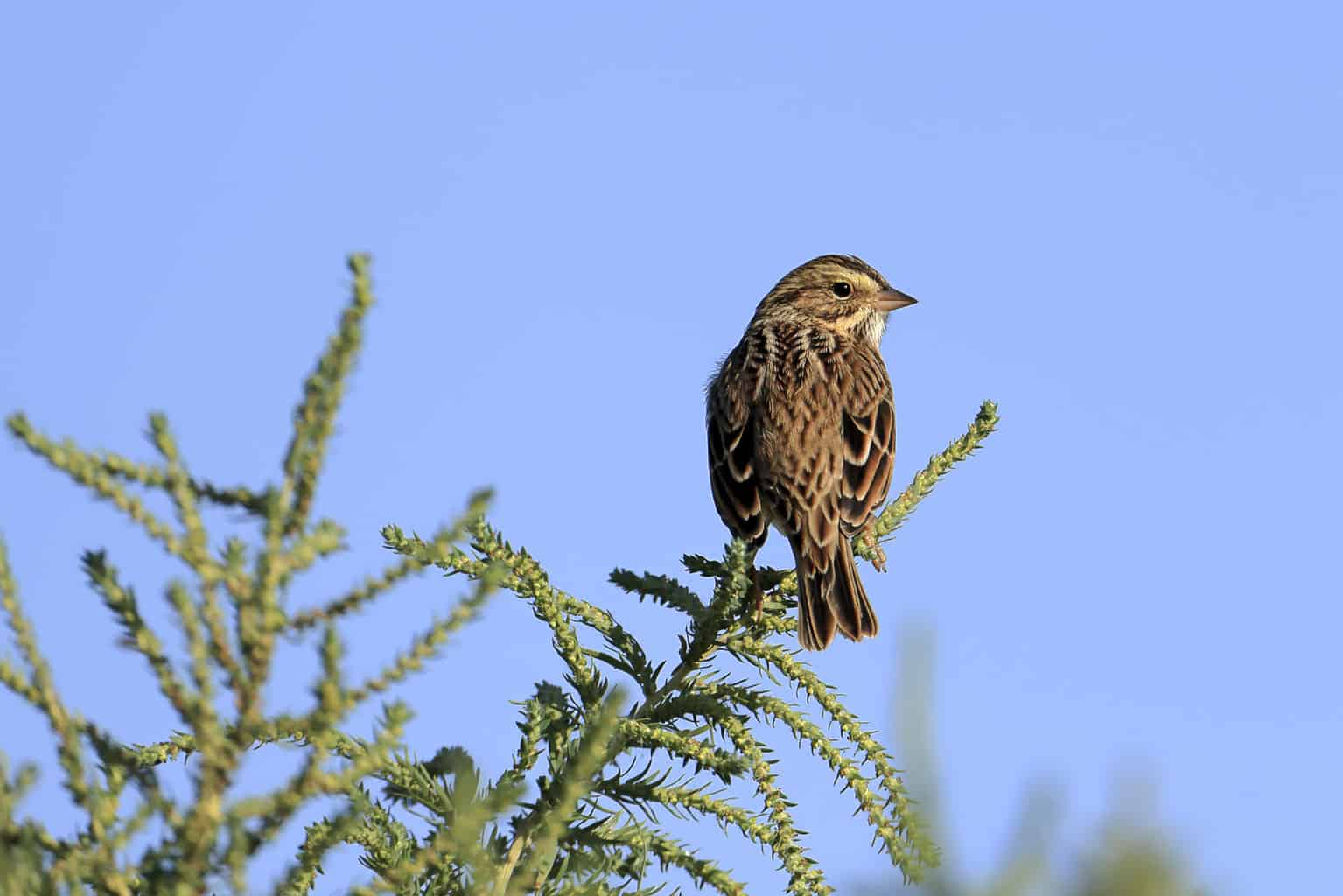
- Melospiza lincolnii
- ORDER: Passeriformes
- FAMILY: Passerellidae
- Length: 5.1-5.9 in (13-15 cm)
- Weight: 0.6-0.7 oz (17-19 g)
- Wingspan: 7.5-8.7 in (19-22 cm)
The Lincoln’s Sparrow has brown and gray stripes and a brown-tipped tail and wings. Their bellies are white, and they have a few distinctive facial markings: a pale “mustache” and a brown crown with a gray stripe down the middle.
Lincoln’s Sparrows migrate north anytime between late March and May. Their fall migration south starts in September.
Some Lincoln’s Sparrows will spend the winter in the area around Las Vegas. They are solitary birds during the winter, but if you see them in the rest of the state during their migration, you will likely see them in groups with other sparrows, especially Swamp Sparrows, Song Sparrows, and White-Crowned Sparrows.
Go Find Some Sparrows in Nevada!
As you can see from our list, there are plenty of sparrows in Nevada, many of which are here year-round. Most of these sparrows are here in the summer, but which ones you see will depend on where you are in the state – and what season it is.
Whether you are a birder who lives in Nevada or you’re just visiting, consider adding sparrows to your area of expertise! They are almost always around, and you can practice your bird identification skills by paying close attention to the subtle differences between one type of sparrow and the next.
Don’t forget that we also have a Nevada Bird Guide that will walk you through many of the other interesting birds in the state, from stunning jays and corvids to the tiniest little hummingbirds.

